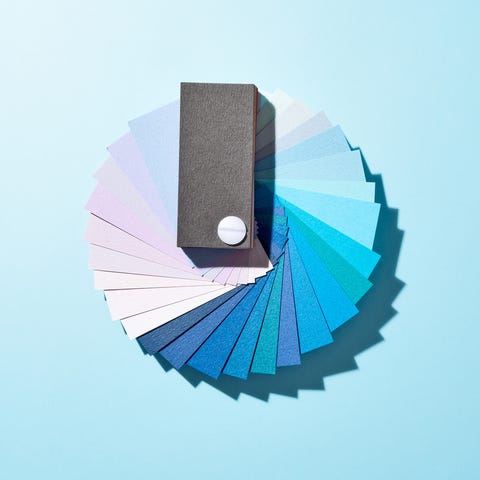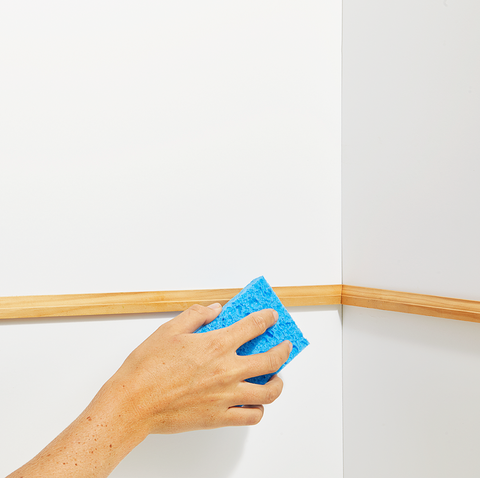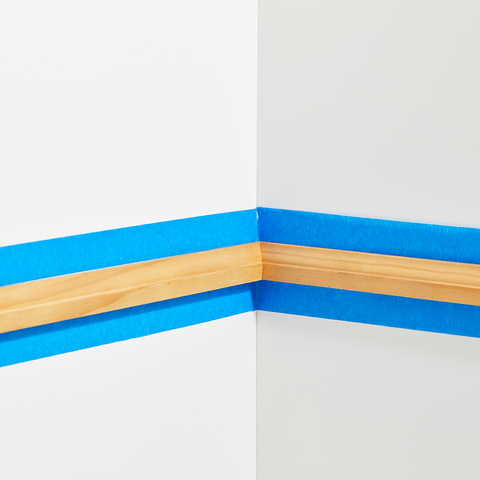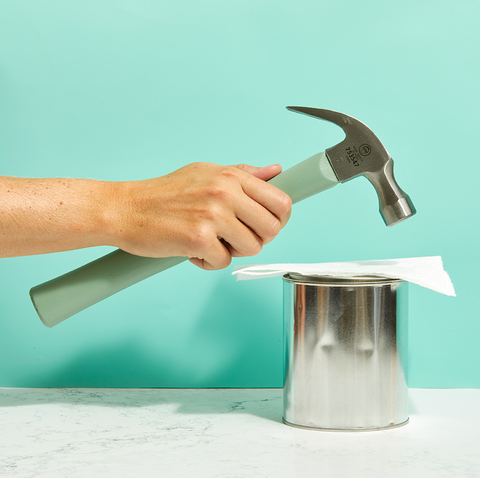How To Paint An Interior Room
Does your space experience a piffling... drab? Switching up your wall colour in a trendy shade is the one of the quickest means to rehab a tired space. And since it'south a project most homeowners tin tackle themselves, it's one of the almost affordable, too.
Only every bit like shooting fish in a barrel every bit painting sounds, there are some tricks to the merchandise. Take prep work, for example. If you skip this important step, you could terminate up with a real problem on your hands — an undercoat that shows through or peeling paint. If y'all're painting latex over oil, for example, you'll likely get great, says Rachel Rothman, chief technologist and director of engineering at the Good Housekeeping Institute. These types of mistakes non only take time to remedy, just can too cost a significant corporeality of money if you have to hire a professional to set up your errors.
Don't fret, though: Equally long every bit you're using the correct supplies and have a handle on the nuts, you'll exist painting like a pro in no fourth dimension at all. Here, we'll break it all downwards for you lot, covering everything from supplies, to necessary prep, to rolling evenly, and even cleaning your brushes so y'all can move on to the adjacent projection on your list. Follow these tips for professional-looking results:
1. Make a program.
Before you ever pick up a paint brush, you need a plan of attack. Call up of information technology sort of similar cooking: You want to read the recipe all the style through earlier yous start blindly throwing ingredients into the pot, otherwise, you might get halfway through and realize you're missing an important component.
Look up: Does the ceiling need a refresh, too? What nigh the trim? Consider your options on the walls likewise. Volition you be using ane colour — or practise you want to effort painting with two colors (an accent wall, perhaps)?
two. Select the perfect color.
When it comes to pigment shades, the options are boundless. It's a fortunate trouble: While you lot'll inevitably detect just what your'e looking for, landing on the right hue can be quite the procedure. To guide your search, start by thinking about what you ultimately want. Do you envision a warm or a absurd shade? Does your space warrant a bold colour, or would a neutral be more than appropriate? Once you have a general idea of the direction you want to go in, y'all tin begin sifting through paint fries.
But don't rely on the little square to make a final determination: In one case on the wall, paint tin look very different than it does on the sample card! Colors often look brighter once on the wall, and the low-cal in your room tin can have a dramatic impact on the way the color reads. Choice a few finalists, then purchase sample cans.
iii. Pigment a sample swatch.
Once you have sample cans in mitt, paint swatches on the wall. To give you a good idea of how the colour volition look in your space, paint two coats of color in a 12-inch-by-12-inch square. If your room has both sunny and shady spots, it's smart to put swatches in both areas, as this can touch the final expect.
Alternatively, you lot can paint two coats onto a foam board (available at any craft or function supply shop) and tape information technology to the wall. This is a great pick for those who don't intend to go started right away, as you won't have to live with random color streaks on your walls.
Pro tip: Use an inexpensive cream brush for this type of sample painting. This style, yous won't dirty a ton of brushes or waste coin.
4. Calculate how much pigment you need.
When determining how much paint to purchase, many retailers have helpful calculators yous can use. Always double check packaging, but in general, a gallon is roughly good for 250 to 400 square anxiety, says Rothman. And don't forget: You'll need a little extra for bear upon-ups and mistakes.
5. Gather the right materials.
Though the surface and size of what your painting volition directly influence the exact list of supplies you need, it'due south a practiced idea to stock your toolkit with some combination of the following items:
- Painter's tape
- Driblet cloths
- Pigment brushes (both angled and straight)
- Paint roller
- Pigment tray
- Stir stick
- Paint
Other worthy investments: An extension pole, then y'all can stash away the ladder later the edging step; a pigment-can opener; and a pour spout to lessen mess.
six. Prep the room for painting.
- First, dry out-grit the walls flooring to ceiling and scrub any actress-grimy parts with a wet sponge or textile; paint won't adhere every bit well to a dirty surface (think fingerprints, soot, dust, cobwebs). Let dry out earlier you paint.
- Protect the floor and any furniture you lot can't (or don't want to) move, from paint splatters and spills. For the flooring, choose fabric drib cloths instead of plastic ones, as plastic can be slick under your feet or, worse, the ladder.
- Remove outlet and light switch plates and tape effectually any areas you don't desire painted (such equally moldings, baseboards, or window frames) with painter'southward masking tape or Frog Tape. The Skillful Housekeeping Plant tried the latter on a smooth wall and found that it makes a well-baked line and doesn't permit paint drain through.
7. Prime the wall (or don't with our handy trick).
A bit of a hinderance when you're trying to paint a room in i day: Painting over a dark wall with a light color (or covering stains) requires a coat of primer and two coats of paint — and at least six hours of drying time. (If you're in a super humid room or painting the outside on a boiling 24-hour interval it will accept a much longer, notes Rothman.)
That'due south why GHI recommends Benjamin Moore Aura, a self-priming paint (it'south a cost-effective option if you were planning on buying primer). Going from light to light? You can become away with two coats of good-quality regular paint.
8. Mix the pigment.
Though the store generally shakes the paint for you lot, a decent stir will ensure your paint is properly mixed. This is particularly important if the can has been sitting on a shelf for any length of fourth dimension. Though an optional footstep, you can besides strain the pigment, says Rothman. "It's easier to go rid of impurities from the pigment can, rather than having them on your wall and having to fix it later."
nine. Go rolling!
Now you're ready for the main consequence. If you're painting a room with two colors — stripes, for example — start with the lighter color showtime, says Rothman. One time information technology's dry, run painter's record over the divider, then paint the darker color.
If y'all're painting a room one color, here's how with a roller and a brush, according to the pros:
- Use an angled brush or a sponge tool to "cut in," or pigment a two-inch swath around the edges of woodwork and the ceiling. (Don't forget: These areas should exist taped off, every bit explained in footstep five.)
- Grab your paint tray and a roller. Use i/four-inch nap for smooth surfaces, 3/8-inch nap for semi-shine, or 5/8-inch nap for rough — the wrong tool volition apply too much or likewise footling pigment. If using a latex paint, pre-wet the roller kickoff, says Rothman.
- Fill the well of the pigment tray nearly ¼ of the mode. Then, when loading the paint, roll the roller back and forth in the well until information technology is uniformly covered. Finally, move the roller dorsum and forth in the upper portion to remove any excess.
- Fill in the cardinal unpainted space using the roller. Paint the wall in overlapping W- or Thou-shaped strokes for the most fifty-fifty paint distribution.
- Let the first coat dry at to the lowest degree a couple of hours, so coat again. Betwixt coats, cover the tray and brush with plastic wrap touching the paint surface, and refrigerate.
Pro tip: Have a moist rag handy to wipe fresh splatters. Scrape off stale drips with a credit card or plastic spatula.
10. Terminate and clean up.
- Rinse your paintbrush and roller (if you don't toss it) under a faucet until the h2o runs clear.
- Decant the tray'southward leftover paint back into the can; seal the can tightly past placing a paper towel over the lid and tapping the chapeau edges with a hammer. Rinse the tray.
- In one case the castor's bristles are totally dry, slip the brush back into its original paper wrapper to keep the bristles from fanning out, or endeavor this DIY fix: Fold a thick piece of paper effectually the bristles; record to secure.
- Remove masking tape before you telephone call it a dark, pulling it off at a 45-degree angle to avoid vehement the finish.
This content is created and maintained by a tertiary party, and imported onto this page to help users provide their electronic mail addresses. You may exist able to find more information about this and similar content at piano.io
Source: https://www.goodhousekeeping.com/home/renovation/advice/a18680/how-to-paint-a-room/
Posted by: velazquezhounat.blogspot.com






0 Response to "How To Paint An Interior Room"
Post a Comment